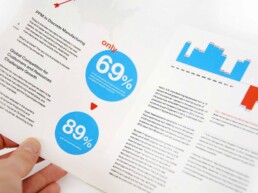5 Ways to Use Visual Storytelling for Web
Visual storytelling, when combined with the right measure of image and often sound, creates a level of connection and intrigue that no other technique can achieve. Emotion, anticipation, and stimulation reward the active participant with a resulting heightened engagement for the site owner.
Alternately, average (static) content puts the user in a passive mode where they either consume the content or leave the website altogether. Visual stories, on the other hand, are interactive and get people to commit themselves to your story. There are several effective platforms to apply visual storytelling in the digital environment. Working with a content team to develop stories and narrative around the brand, and a creative team to implement the visuals will deliver the best outcome.
#1: Use Your Words
Storytelling via typography can be effective, however, the content must be relevant and cohesive. Taking into consideration the idea of cognitive fluency, many users only read about 20% of the content on a website. Clearly defining the messaging that is most important, and displaying it in a typographically interesting way can increase conversions greatly. Visual storytelling via text may be the most popular and easiest method to produce but it’s not always the most engaging, particularly if the content is not fully developed for the targeted audience.
#2: A Picture is Worth…
The brain is able to process imagery approximately 60K times faster than text alone. Using static images, data backed infographics and background images can help to explain how a product works or convey a specific feeling while leaving room for personal interpretation. The combination of visuals and text helps to move a story along.
#3: Spring to Life
Interactivity and animation will take visuals to the next level of engagement. When the user is entertained they are much more likely to listen and want to learn more. An interactive site means anything and everything from contests to displaying products in a way that encourages or even requires visitors to click on certain categories. By displaying products in an interactive way rather than just pictures, you are more likely to engage visitors. A great example of this method is parallax scrolling.
#4: Music is what feelings sound like
Storytelling through an sound is one of the most emotion provoking methods of engagement. A voice, melody, sound effect or song will catch the attention of a user and, if the reaction is positive, draw them in further to more information. Songs, when applied, already tell a story so it’s important to ensure that the message being conveyed is relative to the content of the site. Additionally, a voice – woman, man, child, deep or bright will bring an instant point of view to the messaging being narrated. Taking these aspects into consideration, it’s important to be thoughtful when choosing audio no matter the platform.
#5: Show, don’t Tell
The use of video and moving image has been the topic of much discussion with regard to the digital environment lately. With the addition of video features, social media has become a truly interactive landscape. Analytics show that the presence of a video as opposed to static image or text alone can increase engagement by at least 200 percent. Moving visuals are retained by the long term memory because of connection. If that connection is made with the user, they are more likely to retain and engage on a long term basis.
The bottom line is that stories, whether told via sound or motion, attract users in a powerful way. Striking a balance between relevant content and the encouragement of emotion will create the most impact.
Revolutionizing UX Design with the Binary Approach to Project Management
Embracing a clear approach to task completion—where tasks are strictly marked as 'done' or 'not done'—can significantly enhance the efficiency, clarity, and accountability of UX projects. This project management method offers a straightforward…
Human-Centered Design: The Heart of Creating Impactful Digital and Physical Experiences
Whether it be digital, physical, or conceptual, one philosophy consistently emerges as the cornerstone of impactful and effective creation: Human-Centered Design (HCD). At its core, Human-centered design isn’t just a methodology; it’s a…
The Conundrum of Empathy in UX Design: A Driving Force or an Unrealistic Ideal?
Empathy is often touted as the backbone of user experience (UX) design, a tool to perceive and feel what end users might experience. However, the practicality and efficacy of empathy in UX design is a subject of intense debate. While empathy can be…



